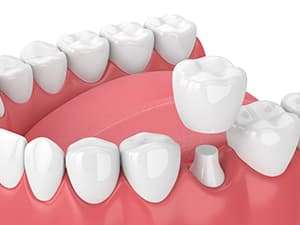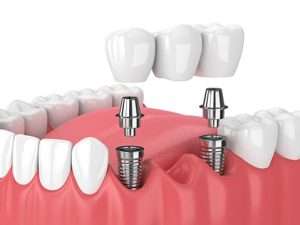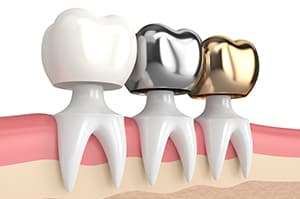Bridges & Crowns
Regain your confidence and smile freely when you make the choice to get bridges and crowns to repair your teeth.
We give you a virtual high five for visiting this page and considering our cosmetic dentistry services. We take this super seriously and will do our best to support your best smile!
Learn more about crowns & bridges on this page.

Your Smile is the First Impression You Give.
MAKE IT COUNT.
BRIDGES AND CROWNS
Looking to replace a missing tooth with a dental bridge? Need a crown to repair a broken tooth? Regain your confidence with a dental bridge or crown from Premier Dental Care. Our team of dental experts are proud to provide the best dental service in Watertown and surrounding areas. Keep reading to learn more about bridges and crowns.

WHAT IS A CROWN?
A crown is a tooth-shaped cap that is fixed to the top of a tooth that is broken, decayed, misshapen or discolored. A crown completely covers a tooth above the gum line. Crowns can be used for cosmetic purposes or to protect a tooth from breakage if its structure has been compromised. Crowns strengthen damaged teeth, allowing them to function normally again. When crafted from today’s high-tech porcelains (dental ceramics), crowns are virtually indistinguishable from natural teeth. They can even be designed to improve upon a tooth’s original appearance.
Crowns can be ceramic or crafted from metal, zirconia, porcelain fused to metal, or porcelain fused to zirconia. Your dentist will recommend a material for your crown based on how your teeth meet and your lifestyle.
Crowning or capping a tooth will usually take two visits. At the first visit, your tooth is prepared to receive its new crown. First, it is shaped to fit inside the new covering. This will involve some drilling to give the tooth a uniform shape. The tooth and the surrounding area will be numbed beforehand. If there is very little tooth structure left to begin with, the tooth may have to be built up with filling material, rather than filed down, to support the crown.
After the tooth is prepared, impressions of your teeth are taken with reliable, putty-like impression materials, and sent to the dental laboratory. There, the impressions will be used to make models of your teeth for the fabrication of a crown. The models will serve as guides to the highly skilled lab technicians, who will ensure that your new crown is designed to enhance your smile and function well within your bite.
Before you leave the office, a temporary crown will be attached to your tooth to protect it until the permanent crown is ready. At the second visit, your permanent crown will be attached to your tooth with either a resin that hardens when exposed to a special light source, or a type of permanent cement.

WHAT IS A BRIDGE?
A bridge is a prosthetic used to fill a gap that is caused by a missing tooth. While a bridge can also have cosmetic benefits, they are mainly used to prevent the teeth that surround a gap from shifting and triggering gum disease or a joint disorder.
Crowns can also be used to create a lifelike replacement for a missing tooth. This is done with bridgework, which spans the space of the missing tooth and requires at least three crowns. Two of those crowns will be placed over healthy teeth on either side of the missing tooth; these healthy teeth are referred to as abutment teeth. The two crowned abutment teeth become supports for a third crown placed in between them; that third crown is referred to as a pontic. If more than one tooth is missing, more crowns will be needed to bridge the gap in between the abutment teeth.
The number of abutment teeth necessary to replace missing teeth is influenced by the number of missing teeth, the size and length of the abutment tooth roots, the amount of bone support each abutment tooth has, as well as where in the mouth the missing tooth is located. For example, if you have three missing teeth, four abutment teeth may be necessary, thereby creating a seven-tooth bridge. Engineering and designing of the bridge requires an understanding of how to replace teeth, as well as the biology of the supporting gum and bone tissue.
HOW DO I KNOW IF I NEED A BRIDGE OR CROWN?
Most crowns are needed to cover a chipped or fractured tooth or a tooth that needs a filling and doesn’t have enough natural tooth left. Your dentist may also recommend a crown to protect a tooth that has had a root canal. Bridges are primarily used to fill gaps in between teeth that are caused by a missing tooth.
TYPES OF DENTAL BRIDGES
Traditional bridges are the most popular. They are made from a combination of metal and porcelain or ceramic. A crown is applied to the teeth adjacent to the cap with a pontic attached between them.
Cantilever bridges are made from the same material as a traditional bridge but are used when there’s only one adjacent tooth to work with. In this case, only one end of the bridge has a crown that the pontic is attached to.
Maryland bridges are made from metal or ceramic wings with a false tooth placed in a framework between them. The wings are cemented to the adjacent teeth to hold the false tooth in place.

TYPES OF DENTAL CROWNS
- Ceramic crowns, which have a porcelain base, are best for highly visible teeth as the color can be matched to the same shade as your natural teeth.
- Metal and porcelain crowns create a strong protective seal and strengthen the structural integrity of the tooth.
- Gold alloy crowns are good for sensitive gums and do not wear down easily.
What are you waiting for?
We’re genuinely excited to meet you.
Click the button below to schedule your appointment online.
You can also call our office at 617-923-8100
to ask any questions or make your first appointment.

We’ve prepared a blog for you about crowns and bridges if you want to brush up on some info an in easy-to-understand format:
